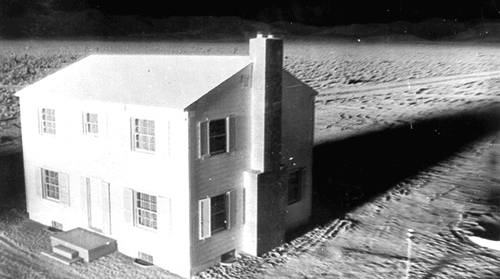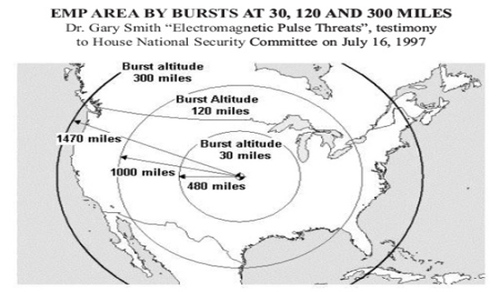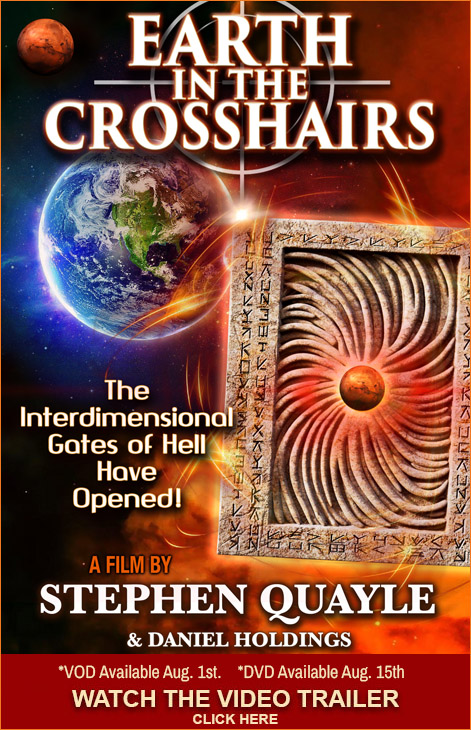For decades, movies and some in the media have portrayed a nuclear attack as a “doomsday” event implying most people would be killed on impact … and survivors would want to die once they come out of their shelters.
In reality, unless you are actually at ground zero or within a several mile radius of the blast zone (depending on the size of the nuke, of course), there is a very high probability you’ll survive as long as you…
- limit your exposure to radiation and fallout,
- take shelter with proper shielding, and
- wait for the most dangerous radioactive materials to decay.
In other words, you CAN survive a nuke attack … but you MUST make an effort to learn what to do! By learning about potential threats, we are all better prepared to know how to react if something happens.
What happens when a nuke explodes?
A nuclear blast produces a blinding light, intense heat (called thermal radiation), initial nuclear radiation, 2 explosive shock waves (blasts), mass fires, and radioactive fallout (residual nuclear radiation).
The below graphic shows the destruction of a test home by an atomic blast on March 17, 1953 at the Nevada Proving Ground. The structure was located 3,500 feet from ground zero, and the time from the first to last picture was 2.3 seconds. It shows the force of the blast wave then the radiating energy set it on fire. (See more nuke test photos in our Fire in the Sky post.)

Also, if a nuke is launched over our continent and explodes miles above the earth, it could create an electromagnetic pulse (EMP). An EMP is a split-second silent energy burst (like a stroke of lightning) that can fry electronics connected to wires or antennas like cell phones, cars, computers, TVs, etc. Unless electronics are grounded or hardened, an area or nation could experience anything from minor interference to crippled power, transportation, banking and communications systems.
An EMP from a high-altitude nuke (where a nation or group succeeds in detonating a nuclear device carried miles into the atmosphere) could affect electronics within 1,000 miles or more as shown below. (Evidence suggests some countries and groups are working on enhanced and non-nuclear EMP weapons or e-bombs.)

What is the most dangerous part of a nuclear attack?
Both the initial nuclear radiation and residual nuclear radiation (also called radioactive fallout) are extremely dangerous.
Initial nuclear radiation is penetrating invisible rays that can be lethal in high levels.
Radioactive fallout (residual nuclear radiation) is created when the fireball vaporizes everything inside it (including dirt and water). Vaporized materials mix with radioactive materials in the updraft of air forming a mushroom cloud.
Fallout can be carried by winds for hundreds of miles and begin falling to the ground within minutes of the blast or take hours, days, weeks or even months to fall. The heaviest fallout would hit ground zero and areas downwind of that, and 80% of fallout would occur within 24 hours. Most fallout looks like grey sand or gritty ash and the radiation given off cannot be seen, smelled, tasted or felt which is why it is so dangerous. But as the materials decay or spread out radiation levels will drop.
Radiation detection devices – SINCE You cannot see, smell, taste or feel radiation, special instruments can detect even the smallest levels of radiation. Since it may take days or weeks before First Responders could get to you, consider having these devices handy during a crisis or attack since they could save your life.
Survey meter – measures rate of exposure or intensity of radiation at that specific location if you stayed there for an hour … like a speedometer in a car (cost: $300-$1,000+)
Dosimeter – a pen-like device you can wear that measures total dose or accumulated exposure to radiation as you move around (needs a charger too). Dosimeters cost about $45-$65+ each and some dealers offer 3 dosimeters + a charger for about $240 or so.
Measuring radiation – Radiation was measured in units called roentgens (pronounced “rent-gens” and abbreviated as “R”) … or “rads” or “rem”. An EPA document called “Planning Guidance for Response to A Nuclear Detonation 2nd Edition June 2010” explains … 1 R (exposure in air) ≅ 1 rad (absorbed dose) ≅ 1 rem (whole-body dose). Although many measuring devices and older documentation use R and rem, officials and the media now use sievert (Sv) which is the System International or SI unit of measurement of radiation. The formula to convert sieverts to rems is quite simple … 1 Sv = 100 R (rem).
How many rads are bad? – High doses of radiation in a short span of time can cause radiation sickness or even death, but if that high dose is spread out over a long period of time, it’s not as bad.
According to FEMA, an adult could tolerate and recover from an exposure to 150R (1.5 Sv) over a week or 300R (3 Sv) over a 4-month period. But 300R (3 Sv) over a week could cause sickness or possibly death. Exposure to 30R (0.3 Sv) to 70R (0.7 Sv) over a week may cause minor sickness, but a full recovery would be expected. But radioactive fallout decays rapidly so staying in a shelter with proper shielding is critical!
The “seven-ten” rule – For every sevenfold increase in time after the initial blast, there is a tenfold decrease in the radiation rate. For example, a 500 rad level can drop to 50R in just 7 hours and down to 5R after 2 days (49 hours). In other words, if you have shelter with good shielding and stay put for even just 7 hours … you’ve really increased your chances of survival. Your detection devices, emergency radio or cell phone [if the last 2 are working, that is] can assist you in knowing when it’s safe to come out.
So how do I protect myself and my family?
Basic shelter requirements – Whether you build a shelter in advance or throw together an expedient last-minute shelter during a crisis, the area should protect you from radiation and support you for at least 2 weeks. Some basic requirements for a fallout shelter include …
- shielding
- ventilation
- water and food
- sanitation and first aid products
- radiation monitoring devices, KI (potassium iodide), radio, weapons, tools, etc
Reduce exposure – Protect yourself from radioactive fallout with …
- distance – the more distance between you and fallout particles, the better
- shielding – heavy, dense materials (like thick walls, earth, concrete, bricks, water and books) between you and fallout is best. Stay indoors or below ground. (Taking shelter in a basement or a facility below ground reduces exposure by 90%. Less than 4 inches of soil or earth can reduce the penetration of dangerous gamma rays by half.)
- time – most fallout loses its strength quickly. The more time that passes after the attack, the lower the danger.
Indoor shelter locations – If you don’t have a fallout shelter, these options could provide protection from dangerous radiation by using proper shielding materials.
- basement – find the corner that is most below ground level (the further underground the better)
- 1-story home / condo / apartment – if no underground facility, find a spot in center of home away from windows
- trailer home – find sturdier shelter if possible (like a basement or brick or concrete building)
- multi-story building or high-rise – go to center of the middle section of building (above 9th floor if possible). Note: if rooftop of a building next to you is on that same floor, move one floor up or down since radioactive fallout would accumulate on rooftops. Avoid first floor (if possible) since fallout will pile up on ground outside.
Shielding materials – All fallout shelters must provide good protection from radioactive particles. FEMA suggests having a minimum of several inches of concrete or 1 to 2 feet of earth as shielding around your shelter, if possible, and the more the better. Per FEMA, the following shows examples of shielding materials that equal the protection of 4 inches (10 cm) of concrete …
- 5 – 6 inches (12 – 15 cm) of bricks
- 6 inches (15 cm) of sand or gravel
- 7 inches (18 cm) of earth
- 8 inches (20 cm) of hollow concrete block
- 10 inches (25 cm) of water
- 14 inches (35 cm) of books or magazines
- 18 inches (46 cm) of wood
Make an expedient shelter – Some very basic ways to build an expedient last-minute shelter in your home, apartment or workplace to help protect you from dangerous radiation include…
- Set up a large, sturdy workbench or table in location you’ve chosen. If no table, make one by putting doors on top of boxes, appliances or furniture.
- Put as much shielding (e.g. furniture, file cabinets, appliances, boxes or pillowcases filled with dirt or sand, boxes of food, water or books, concrete blocks, bricks, etc.) all around sides and on top of table, but don’t put too much weight on tabletop or it could collapse. Add reinforcing supports, if needed.
- Leave a crawl space so everyone can get inside and block opening with shielding materials.
- Leave 2 small air spaces for ventilation (about 4-6″ each) – one low at one end and one high at other end. (This allows for better airflow since warm air rises.)
- Have water, radiation detection devices, KI, battery operated radio, food and sanitation supplies in case you have to shelter in place for days or weeks.
- In summary, those within the blast zone of Ground Zero (depending on the size of the nuke) won’t make it .. BUT .. if you are a few miles outside the zone your chances of surviving it are high but you MUST have detection devices to monitor levels of radiation and a plan to stay sheltered for at least 48 hours or up to a few weeks. First Responders will have to wait for the deadly fallout to decay before they enter a hot zone so the more you prepare, the better your odds of surviving a terrorist nuke.
Some other items that we can purchase now that could make the difference between life and death include.
Jackery Solar Generator 1000, 1002Wh Portable Power Station Explorer 1000 and SolarSaga 100W with 3x110V/1000W AC Outlets, Solar Mobile Lithium Battery Pack for Outdoor RV/Van Camping, Emergency
BLUETTI AC50S Portable Power Station 500Wh Solar Generator Lithium Battery Backup for Outdoor Camping RV Trip (Regulated 12V, MPPT, Wireless Charging,PD 45W USB-C, Pure Sine-Wave, LED Lighting,2 AC)
Portable Power Station 2021 Upgrade, 615Wh LiFePO4 Battery with 500W 2x AC Outlet/QC/USB-C/Flashlight, Silent Solar Generator for Home Use CPAP Outdoor Camping (Panels Not Included)
Westinghouse Outdoor Power Equipment WGen9500DF Dual Fuel Portable Generator-9500 Rated 12500 Peak Watts Gas or Propane Powered-Electric Start-Transfer Switch & RV Ready, CARB Compliant
DuroMax XP10000E Gas Powered Portable Generator-10000 Watt Electric Start-Home Back Up & RV Ready, 50 State Approved, Blue/Black
DuroMax XP5500EH Electric Start-Camping & RV Ready, 50 State Approved Dual Fuel Portable Generator-5500 Watt Gas or Propane Powered, Blue/Black
Nuclear Radiation Detector,Radiation Survey Meter,β γ χ Ray Gamma Nuclear Radiation Detector,Dosimeter Radioactive Alarm,with LCD Display, Clear Reading, Easy to Operate
Emergency Communications:
Garmin inReach Mini GPS Satellite Communicator
First Aid Kits:
Surviveware Waterproof First Aid Kit and Surviveware Survival First Aid Kit (Camo) Bundle
Wise Company Long Term Emergency Freeze-Dried Food Supply, Breakfast and Entree Variety
MRE Meals - 124-Serving Freeze Dried Emergency Food Supply
Long Term Dehydrated Food Storage - 120 Large Entree Servings - 29 Lbs- Disaster Prepper Freeze Dried Supply Kit
Wise Company ReadyWise, Emergency Food Supply, Emergency Freeze Dried Fruit Bucket, 120 Servings
Wise Company Emergency Food Supply, Freeze Dried Meat Variety, 15-Year Shelf Life, 60 Servings
Wise Company Emergency Food Supply, Variety Pack, 25-Year Shelf Life, 104 Servings
Wise Company ReadyWise, Emergency Food Supply, Freeze Dried Vegetables, 120 Servings
Mountain House Classic Bucket | Freeze Dried Backpacking & Camping Food | 24 Servings
Mountain House Diced Beef #10 Can Freeze Dried Food - 6 Cans Per Case
Mountain House Cooked Diced Chicken #10 Can
Augason Farms Lunch and Dinner Variety Pail Emergency Food Supply 4-Gallon Pail
Augason Farms Breakfast Emergency Food Supply 11 lbs 1.8 oz 4 Gallon Pail
Fruit pails or buckets
PB2 Original Powdered Peanut Butter - [2 Lb/32oz Jar]
Augason Farms Vegetable Stew Blend 2 lbs 0.5 oz No. 10 Can
It's Just - Whole Egg Protein Powder, Made in USA, Non-GMO (8oz)
Augason Farms 5-90158 Scrambled Egg Mix, 2 lbs, 4 oz. No. 10 Can
Augason Farms Dried Whole Egg Product 2 lbs 1 oz No. 10 Can
Hoosier Hill Farm All American Dairy Whole Milk Powder 1 lb
Hoosier Hill Farm Heavy Cream Powder Jar, 1 Pound
Hoosier Hill Farm Real Butter powder, Gluten and Hormone.free, 2 lbs
Augason Farms Dehydrated Chopped Onions 1 lb 7 oz No. 10 Can
Nutristore Freeze Dried Mozzarella Cheese Shredded Premium Quality
Canned/Packaged Goods:
Wellsley Farms White Premium Chunk Chicken Breast in Water, 12.5 Ounce, 6 Count
Keystone Meats All Natural Canned Chicken, 28 Ounce by Keystone Meats
Swanson Chicken į la King Made with White and Dark Meat Chicken, 10.5 Ounce Can (Pack of 12)
Dinty Moore Beef Stew with Fresh Potatoes & Carrots 20 oz (Pack of 12)
Armour Star Classic Homestyle Beef Stew, 20 oz. (Pack of 12)
Keystone Meats All Natural Canned Beef, 28 Ounce
SAMPCO Shredded Beef 3lb.
Kirkland Signature Chicken Breast (Chicken Breast -6 Count)
Keystone Meats All Natural Canned Pork, 28 Ounce
Armour Star Roast Beef With Gravy, 12 oz.
Armour Star Banner Sausage, Easy Open Can, 10.5 oz. (Pack of 12)
Wild Planet Skipjack Wild Tuna, Sea Salt, Keto and Paleo, 3rd Party Mercury Tested, 5 Ounce (Pack of 12)
Armour Star Luncheon Meat, 12 oz. (Pack of 12)
Canned Vegetables Variety Of Options
Canned Fruits Variety Of Options
Rice
Beans
Pasta
We have also embedded Cresson H. Kearny's must-read classic 'Nuclear War Survival Skills' at the very bottom of this story for you to look over and get some more ideas to help you and your family get prepared for what we pray never comes. And as always, we open up our comment section to your suggestions and ideas, they could save someone else's life.













